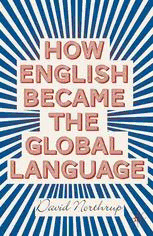
How English Became the Global Language PDF
Preview How English Became the Global Language
HOW ENGLISH BECAME THE GLOBAL LANGUAGE This page intentionally left blank How English Became the Global Language David Northrup HOW ENGLISH BECAME THE GLOBAL LANGUAGE Copyright © David Northrup, 2013. Softcover reprint of the hardcover 1st edition 2013 978-1-137-30305-9 All rights reserved. First published in 2013 by PALGRAVE MACMILLAN® in the United States— a division of St. Martin’s Press LLC, 175 Fifth Avenue, New York, NY 10010. Where this book is distributed in the UK, Europe and the rest of the world, this is by Palgrave Macmillan, a division of Macmillan Publishers Limited, registered in England, company number 785998, of Houndmills, Basingstoke, Hampshire RG21 6XS. Palgrave Macmillan is the global academic imprint of the above companies and has companies and representatives throughout the world. Palgrave® and Macmillan® are registered trademarks in the United States, the United Kingdom, Europe and other countries. ISBN 978-1-137-30306-6 ISBN 978-1-137-30307-3 (eBook) DOI 10.1057/9781137303073 Library of Congress Cataloging-in-Publication Data Northrup, David, 1941– author How English Became the Global Language / David Northrup. pages cm Includes index. 1. English language—Globalization. 2. English language—History. 3. English language—Foreign countries. 4. English language—Variation. I. Title. PE1073.N67 2013 420.9—dc23 2012038715 A catalogue record of the book is available from the British Library. Design by Newgen Imaging Systems (P) Ltd., Chennai, India. First edition: March 2013 10 9 8 7 6 5 4 3 2 1 Contents List of Figures and Tables vii List of Abbreviations ix Preface and Acknowledgments xi Chapter 1 Introduction: Disciplines, Perspectives, Debates, and Overview 1 How Different Disciplines Tell the History of English 2 An Introduction to Language History 7 Debates about Modern History 16 Overview 22 Chapter 2 The Language of the British Isles 27 Invaders 2 8 Modern English 33 English in Scotland, Wales, and Ireland 3 7 Conclusion 4 5 Chapter 3 The Language of North America 4 9 Colonial Beginnings 50 Expansion and Assimilation 5 7 Persistence of Other Languages and Bilingualism 63 Chapter 4 English in Imperial Asia and Africa 75 British Colonies in Asia 78 British Colonies in Africa 8 9 American Colonies in Africa, Asia, and the Pacific 101 vi CONTENTS Chapter 5 Cultural Worlds 1 09 International Relations 110 Scientific English 1 14 Business English 1 18 Global English Literature 123 Popular Culture: Rap and Mac 129 Chapter 6 Tipping Points 137 The World Wide Web 140 Soviet Disintegration 1 41 China Tips Asia 1 44 The Global Academic Language 1 48 Conclusion 1 58 Notes 161 Bibliography 1 81 Index 197 Figures and Tables Figure 6.1 University students going abroad for study, 2009, by destination. 150 Tables 2.1 Borrowings from Hindi, Turkish, and Welsh 40 3.1 New vocabulary in colonial American English (excluding place-names) 50 3.2 Loanwords in nineteenth-century American English 57 4.1 Education in Nigeria and India, 1938–39 9 4 4.2 Annual expenditures for education in British African colonies, 1926 (£ per 1000 population) 96 4.3 African countries using English officially in education 1 01 6.1 English-medium higher education where English is not an official language 1 57 This page intentionally left blank Abbreviations A s is fitting in a work of world history, international abbrevia- tions are used in dates in preference to the abbreviations AD and BC that are common in Western countries. BCE Before the Common Era CE Of the Common Era Two much used texts are cited in abbreviated form: CHEL The Cambridge History of the English Language OCEL The Oxford Companion to the English Language Other shortened terms: EIC East India Company INC Indian National Congress MNC multinational corporation SPCK S ociety for the Promotion of Christian Knowledge SWAPO Southwest African Peoples Organization UK T he United Kingdom of Great Britain and Northern Ireland US T he United States of America
